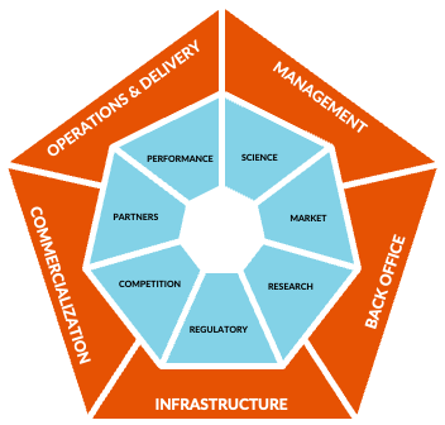At the heart of many corporate strategies is the growth thesis – a premise for how the organization expects to increase revenue, profitability, market share, or other growth-related metric. A growth thesis can involve a wide variety of growth levers – product expansion, market adjacencies, geographic expansion, diversification, M&A, partnerships, channels, and more. Regardless of the levers used, if organizations need to grow to be viable and healthy, then the growth thesis represents one of the most critical aspects of a company’s strategy.
Despite its prominent role in strategy, many organizations do not have a disciplined process for understanding how their capabilities must evolve to support the growth thesis. Successfully unlocking growth opportunities requires capability, capacity, and cross-functional alignment. So how do you know what exactly needs to change for the growth thesis to be achievable?
To answer that question, it is useful to consider the types of constraints that often surface in pursuing a growth thesis.
1. Commercial Constraints
By definition, a growth thesis usually includes commercial expansion: new customers, geographies, and/or offerings. For businesses that are already growing rapidly, there can be a tendency to forego disciplined commercial planning – market research, go-to-market development, sales force design, etc. – in favor of getting into the market faster. But this approach can easily backfire, resulting in a lost opportunity to create impact due to a lack of understanding of the commercial fundamentals. A well-formed growth thesis is backed by a thoughtful analysis of the market dynamics, segments, competitors, positioning, marketing strategy, business development, and sales operations that will drive successful commercialization.
2. Talent Constraints
For many life sciences and healthcare organizations, growth is closely associated with available headcount. If you don’t have the people to do the work, you cannot secure and deliver the revenue. Talent constraints can take multiple forms: employee retention challenges (e.g., market competition, morale, career ladders), barriers to attracting talent (e.g., skilled resource pool, unclear employee value proposition), timing issues (e.g., long lead times, demand variability), and compensation (e.g., benefits design, wage inflation). An effective growth thesis includes a clear strategy for human capital planning that connects people skills and capacity planning to business growth targets.
3. Cultural Constraints
As organizations grow, their cultures invariably evolve as well. Though some cultural elements such as company values may be consistent over time, other cultural issues – collaboration models, communication tactics, management styles, risk tolerance, performance expectations, leadership governance, and more – change as new leaders, employees, business functions, locations, investors, and customer expectations are introduced. This change is especially important for organizations growing through mergers and acquisitions where two or more previously distinct cultures converge. For any growth thesis to be fully realized, the people in that organization need to be engaged and highly aligned through a unified cultural experience.
4. Operational Constraints
As companies grow, their operations must adapt to meet the changing needs. It’s important to consider factors like cost-effectiveness, scalability, and resilience in back-office functions such as finance, legal, supply chain, and inventory management. Additionally, it’s important to assess how well product and service delivery models can accommodate a more diverse customer base. Processes that worked well in the past may become cumbersome and costly as a company expands. For life sciences and healthcare organizations that rely on physical facilities (e.g., contract manufacturers, labs, healthcare service providers), facility-related capacity constraints can be a major obstacle to operational growth due to the time required to expand the capacity.
5. Technology Constraints
How well can your technology solutions scale to the next phase of business operations? Much like the operational constraints above, a company’s software portfolio and system requirements change as they grow as well. Typical areas of impact include enterprise systems (e.g., CRM, ERP, accounting), knowledge worker productivity software (e.g., email, calendar, collaboration, teleconference), network management (e.g., site connectivity), technology design and governance (e.g., enterprise architecture, data integration), systems management (e.g., user administration, system administration, service level monitoring, security), and information technology resourcing (e.g., new technology leadership roles, additional support staff). Changes to technology often offer notable productivity and cost improvements, though they also require change management. The growth thesis offers a pathway for prioritizing these changes in a business-aligned roadmap.
6. Insight Constraints
In the modern business enterprise, effective operations for both organizational leaders and their customers require data-driven insights. When pursuing a growth thesis, the diversification of business data — new products/services, projects, locations, marketing channels, customers, and partners – becomes a factor in developing trusted insights. Without a scalable foundation for business intelligence and operational performance management, growth can be constrained because the organization cannot make informed decisions. Conversely, companies that link their growth strategies to data-driven capabilities outperform their peers on almost every business performance measure (for example, see the studies here, here, and here).
7. Regulatory Constraints
As highly regulated industries, life sciences and healthcare organizations often face growth barriers related to regulatory obligations. Time-intensive product development, submission, and approval processes – spanning drugs, therapies, devices, and diagnostics – are commonly cited growth hurdles. But many regulatory barriers are less about the medical products and more about operations. How long does it take to satisfy GDPR and data privacy requirements? How efficiently can the organization validate its internal systems and processes? A forward-thinking plan for addressing these obligations can help organizations avoid potential bottlenecks.

As these examples illustrate, a disciplined approach to growth thesis planning can considerably accelerate business value creation. By proactively identifying and minimizing the barriers and risks associated with business expansion, organizations can better position themselves to successfully execute growth tactics. In the work that CREO does with our clients, our growth thesis methodology (Figure 1) is often integrated with our strategic planning framework. This integration helps to ensure that annual business goals, quarterly tactics, and organizational investments are aligned to the dependencies inherent in the growth thesis. But regardless of when it is done, deeper assessments of growth feasibility – planning for how thesis-critical capabilities need to evolve to make the growth achievable – should be top of mind for growth-oriented leaders.
 Jason Burke | August 28, 2023
Jason Burke | August 28, 2023


